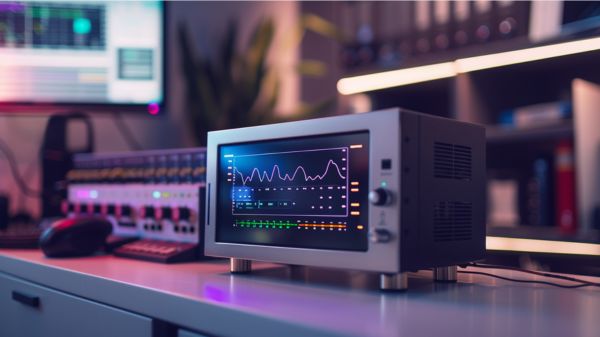When exploring the world of electronics, ponder the pivotal role a function generator plays. Its ability to precisely produce various waveforms is just the beginning of its significance.
But why is this instrument deemed indispensable in the realm of electronics? Let’s dissect the core reasons that elevate a function generator to a must-have tool for engineers and technicians alike.
Key Takeaways
- Function generators enable precise waveform generation for testing and calibration.
- They provide essential frequency and amplitude control for accurate signal production.
- These generators are indispensable in electronics for various testing procedures.
- Future trends include software integration, higher frequencies, and compact designs.
Importance of Function Generators
Function generators serve as indispensable tools in electronics, enabling the precise generation of various waveforms essential for testing and designing electronic circuits.
These devices are crucial for providing accurate sine waves, square waves, triangular waves, and sawtooth waves, allowing engineers and researchers to analyze the behavior of electronic components under different conditions.
The ability to control the frequency and amplitude with precision is paramount when conducting experiments that require specific signal modulation or frequency response analysis.
Function generators play a vital role in tasks such as testing audio equipment for optimal performance, simulating sensor outputs, and calibrating telecommunications systems.
With their versatility and reliability, these instruments are fundamental in the field of electronics, facilitating activities ranging from linear filter testing to sweeping oscillators.
Whether you’re debugging circuits, conducting research, or teaching electronics, the importance of function generators in providing accurate and controlled waveforms can’t be overstated.
Key Features of Function Generators
Transitioning from discussing the importance of function generators, let’s now explore the key features that make these instruments indispensable in electronics.
- Waveform Variety: Function generators produce essential waveforms like sine, square, triangular, and sawtooth waves, crucial for testing and circuit design.
- Frequency Control: These generators offer precise control over frequencies, with models like the 33622A providing 2 channels and 120MHz frequency, and the 33522B offering 30MHz frequency at a discounted rate.
- Arbitrary Waveform Generation: Some function generators allow for arbitrary waveform generation, enabling users to create custom waveforms for specific testing requirements.
These key features make function generators versatile tools in electronics, allowing for accurate testing, flexible waveform generation, and control over frequencies essential for various applications.
Whether you need to produce low phase noise signals or square waves for your circuits, a function generator provides the necessary functionality to meet your testing needs.
Related Post: 10 Best Siglent Technologies to Elevate Your Electronic Testing Experience.
Benefits of Using Function Generators
What advantages do function generators offer in electronics testing and circuit design that make them indispensable tools for engineers and technicians?
Function generators play a crucial role in electronics by providing precise control over signal characteristics such as frequency, amplitude, and waveforms. These instruments are essential for testing electronic circuits as they can generate standard signals like sine, square, triangular, and sawtooth waveforms.
Engineers and technicians rely on function generators for accurate signal generation, aiding in the development and troubleshooting of electronic equipment.
Moreover, function generators are versatile tools for frequency response analysis, sensor simulation, and telecommunications testing. They’re also instrumental in analog amplifier design, linear filter testing, and signal modulation experiments.
With their ability to generate a wide range of signals and facilitate various testing procedures, function generators prove to be indispensable in the field of electronics.
Applications of Function Generators
Applications of function generators extend beyond traditional testing scenarios, providing crucial support for a diverse range of electronic functions and experiments. Here are some key applications where function generators play a vital role:
- Testing Amplifiers: Function generators are crucial for testing amplifiers as they can generate signals of varying frequencies and amplitudes to analyze the amplifier’s performance accurately.
- Signal Processing: In signal processing applications, function generators help create sine waves, square waves, and arbitrary waveforms that are essential for various signal processing experiments and simulations.
- Frequency Range Testing: Function generators with a wide frequency range are usable to analyze the frequency response of electronic components, ensuring they operate within specified ranges.
These applications showcase the versatility of function generators in electronics, making them indispensable tools in research, development, education, and telecommunications testing. Their ability to generate precise outputs makes them invaluable for a wide range of electronic functions and experiments.
Future Trends in Function Generators
Future function generators are anticipated to feature increased integration with software for advanced waveform control. Advancements may focus on higher frequency ranges and improved signal fidelity. Connectivity options for remote operation and data logging are also expected to be enhanced.
Machine learning algorithms could be incorporated for automatic waveform optimization. Industry developments may lead to more compact and portable function generator designs for increased convenience.
| Future Trends in Function Generators |
|---|
| Software Integration |
| Higher Frequency Ranges |
| Connectivity Options |
These advancements showcase a shift towards more sophisticated and user-friendly function generators. By integrating software for waveform control and utilizing machine learning algorithms, future function generators aim to provide precise and customizable waveform outputs.
Higher frequency ranges and enhanced connectivity options further enhance the versatility and usability of these devices. Portable designs make them more accessible in various settings, aligning with the evolving needs of the electronics industry.
Conclusion
A function generator is an indispensable tool in electronics, allowing you to generate a variety of waveforms with precise control over frequency and amplitude.
Remember, ‘necessity is the mother of invention,’ and in the realm of circuit design and testing, a function generator is a must-have for any engineer or technician.
Stay ahead of the curve by utilizing the key features and benefits of function generators for all your electronics needs.




